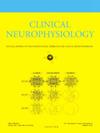Frontal alpha asymmetry in major depression and comorbid anxiety disorder: a five-year follow-up study
IF 3.7
3区 医学
Q1 CLINICAL NEUROLOGY
引用次数: 0
Abstract
Objective
Major depression (MD) and anxiety disorders are both associated with higher left compared to right frontal alpha activity (rLFα). The aim of the study was to examine whether young adults with lifetime MD and anxiety disorder differ from healthy controls and whether this pattern remains stable over five years from adolescence into adulthood.
Methods
Resting frontal EEG asymmetry of n = 25 young adults with lifetime MD and anxiety (MDAnx) and n = 26 healthy controls (HC) was compared. Moreover, in a subsample of participants, the stability of frontal alpha asymmetry was analyzed from adolescence to young adulthood via intra-class-correlations.
Results
Participants with MDAnx displayed significantly more rLFα than HCs. Asymmetry showed fair stability over 5 years in the MDAnx group and poor stability in the HC group, the latter driven by increased relative right frontal alpha activity.
Conclusions
Increased rLFα could be a trait marker for comorbid MDAnx. Low stability in the HC group could derive from maturation of cognitive and affective processes, which might be impeded by the presence of lifetime MDAnx.
Significance
Results highlight that EEG asymmetry changes from adolescence to adulthood and could be impacted by lifetime MD and anxiety, irrespective of current symptomatology.
重度抑郁症和共病焦虑症的额叶α不对称:一项为期五年的随访研究
目的重度抑郁(MD)和焦虑障碍均与较高的左额叶α活动(rLFα)相关。该研究的目的是检查患有终身MD和焦虑症的年轻人是否与健康对照者不同,以及这种模式是否在从青春期到成年期的五年内保持稳定。方法比较25例终身MD伴焦虑青年(MDAnx)和26例健康对照(HC)的静息额叶脑电图不对称性。此外,在参与者的子样本中,通过类内相关性分析了从青春期到青年期额叶α不对称的稳定性。结果MDAnx患者的rLFα明显高于hc患者。MDAnx组的不对称性在5年内表现出相当的稳定性,而HC组的不稳定性较差,后者是由相对右额叶α活动增加引起的。结论rLFα升高可能是MDAnx合并症的一个特征标志。HC组的低稳定性可能源于认知和情感过程的成熟,这可能受到终身MDAnx存在的阻碍。结果强调,脑电图不对称从青春期到成年期发生变化,并可能受到终生MD和焦虑的影响,而与当前的症状无关。
本文章由计算机程序翻译,如有差异,请以英文原文为准。
求助全文
约1分钟内获得全文
求助全文
来源期刊

Clinical Neurophysiology
医学-临床神经学
CiteScore
8.70
自引率
6.40%
发文量
932
审稿时长
59 days
期刊介绍:
As of January 1999, The journal Electroencephalography and Clinical Neurophysiology, and its two sections Electromyography and Motor Control and Evoked Potentials have amalgamated to become this journal - Clinical Neurophysiology.
Clinical Neurophysiology is the official journal of the International Federation of Clinical Neurophysiology, the Brazilian Society of Clinical Neurophysiology, the Czech Society of Clinical Neurophysiology, the Italian Clinical Neurophysiology Society and the International Society of Intraoperative Neurophysiology.The journal is dedicated to fostering research and disseminating information on all aspects of both normal and abnormal functioning of the nervous system. The key aim of the publication is to disseminate scholarly reports on the pathophysiology underlying diseases of the central and peripheral nervous system of human patients. Clinical trials that use neurophysiological measures to document change are encouraged, as are manuscripts reporting data on integrated neuroimaging of central nervous function including, but not limited to, functional MRI, MEG, EEG, PET and other neuroimaging modalities.
 求助内容:
求助内容: 应助结果提醒方式:
应助结果提醒方式:


